By Hiro Ito
Today, we’re fortunate to have Hiro Ito, Associate Professor of Economics at Portland State University as a guest blogger.
While the current global crisis does not show any sign of bottoming out, policy makers around the globe are reevaluating international macroeconomic policies and discussing the post-crisis future of the international financial architecture — as we saw in the recent G20 meeting.
Whatever international macroeconomic policies policy makers discuss, conceptually, they cannot avoid confronting the concept of the “trilemma,” a.k.a., the “impossible trinity”. That is, as Figure 1 shows, a country simultaneously may choose any two, but not all, of the three goals, monetary independence, exchange rate stability and financial integration.

Figure 1: The Impossible Trinity
While it is conceptually powerful and widely taught, little work has been done to empirically prove whether the trilemma is “binding,” or that countries do face trade-offs of the three macroeconomic objectives. This is most probably because appropriate metrics of the extent of achievement in the three policy dimensions are lacking.
Empirical Measurement of the Trilemma
To fill this gap, in a recent paper, Menzie Chinn, Joshua Aizenman (UC, Santa Cruz) and I developed a set of the “trilemma indexes” to measure the extent of achievement in the three goals for more than 170 countries for the period of 1970 through 2006, and tested whether or not the trilemma is “binding”.
Our indexes reveal the striking differences in the choices that industrialized and developing countries have made over the last four decades. Figure 2 below presents the development of trilemma indexes for a balanced panel of 50 countries (32 of which are developing countries) during the 1970-2006 period. The monetary independence index depends on the correlation of a country’s interest rates with the base country’s interest rate, the exchange rate stability index is measured by the exchange rate volatility, and the degree of financial integration is measured with the Chinn-Ito capital controls index.
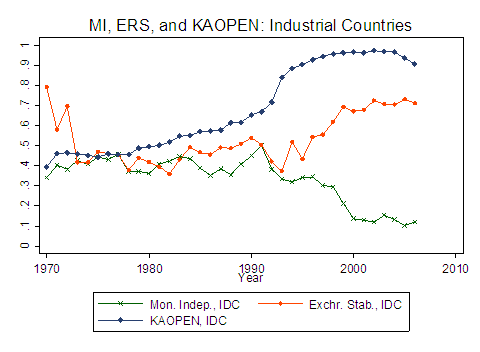
Figure 2a: The Evolution of Trilemma Indexes, Industrial Countries
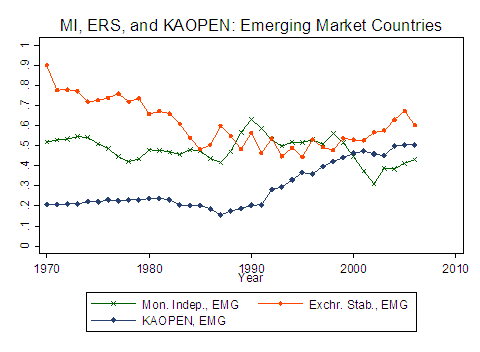
Figure 2b: The Evolution of Trilemma Indexes, Emerging Market Countries
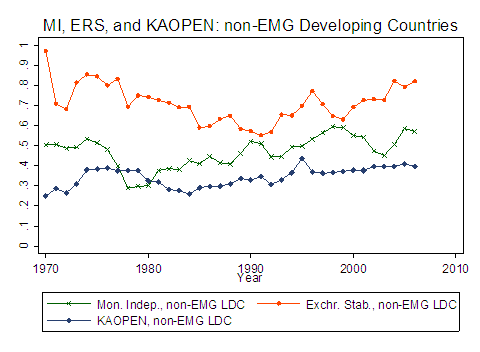
Figure 2c: The Evolution of Trilemma Indexes, Non-Emerging Market Developing Countries
By looking at these figures, we can make the following observations.
After the early 1990s, industrialized countries accelerated financial openness, but reduced the extent of monetary independence while sharply increasing exchange rate stability, all reflecting the introduction of the Euro.
- Emerging market countries pursued exchange rate stability as their key priority up to the late 1980s while non-emerging market developing countries has pursued it throughout the period since 1970.
- Among emerging market countries, the three dimensions of the trilemma configurations are converging towards a “middle ground” with managed exchange rate flexibility, which they seem to attempt to buffer by holding sizable international reserves, while maintaining medium levels of monetary independence and financial integration.
Evolution over Time, Visualized
“Diamond charts” are also useful to trace the changing patterns of the trilemma configurations. Each of the charts below shows the levels of the three policy goals as well as international reserves (as a ratio to GDP) with the origin normalized so as to represent zero monetary independence, pure float, zero international reserves and financial autarky.
In the diamond charts shown below, we can see that Latin American emerging market economies have liberalized their financial markets rapidly since the 1990s after some retrenchment during the 1980s. These economies reduced the extent of monetary independence in recent years and maintained a lower level of exchange rate stability. Emerging Asian economies on the other hand have achieved comparable levels of exchange rate stability and financial openness while consistently reducing monetary independence. This group of economies differ from the other ones the most with their relatively balanced achievement of the three macroeconomic policy goals and their high levels of international reserves holding.
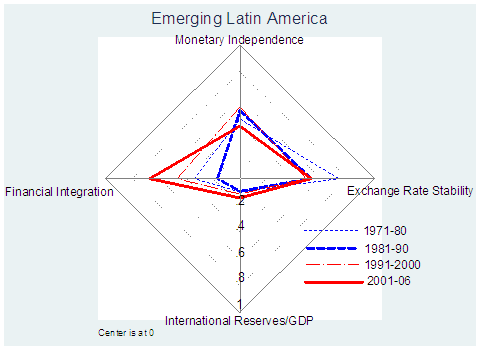
Figure 3a: “Diamond Charts”:
Regional Patterns of the Trilemma Configurations for Developing Countries, Emerging Latin America
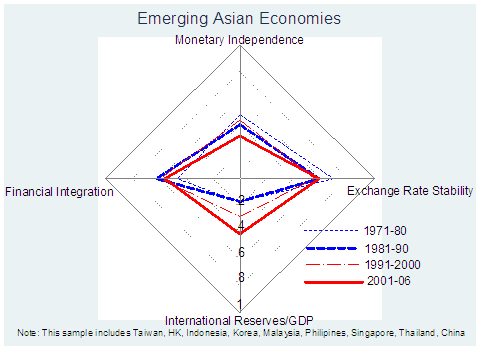
Figure 3b: “Diamond Charts”:
Regional Patterns of the Trilemma Configurations for Developing Countries, Emerging East Asia
Smooth Transition vs. Discrete Breaks; and Tradeoffs
While the system has evolved over time, it would be a mistake to think of the process as being smooth and continuous. Rather, different arrangements have been significantly affected by external shocks. In this regard, we test whether major crises in the last four decades, namely, the collapse of the Bretton Woods system, the debt crisis of 1982, the Asian crisis of 1997-98, the emergence of rapid globalization (1990), and the rise of China (2001), caused structural breaks in the trilemma configurations. We statistically find that these major events have significantly impacted the policy arrangements for both industrialized and developing countries.
Lastly, we test whether the three macroeconomic policy goals are “binding” in the context of the impossible trinity, or whether countries have faced the trade-offs based on the trilemma. Because there is no specific functional form of the trade-offs or the linkage of these three policy goals, we test a simplest linear specification (eq. 1) and examine whether the weighted sum of the three trilemma policy variables adds up to a constant.
1 = aj MIi,t + bj ERSi,t + cj KAOPENi,t + εt
Our results, reported in full in the paper, confirm that countries do face a binding trilemma. This simple linear specification explains well over 90% of the variation in the indexes, indicating that the three policy goals are linearly related to each other. For both subsamples of industrialized and developing countries, the predicted values based on the model hover around the value of one closely and never get beyond statistically. These findings mean that a change in one of the trilemma variables would induce a change with the opposite sign in the weighted average of the other two. In short, the trilemma is binding.
Different Choices, Enduring Tradeoffs
Armed with these results, we can safely anticipate that the present turbulence in the global financial markets could challenge the stability of the current trilemma configuration. However, we need to keep in mind that the idea of tradeoffs will continue to be hold for the new architecture of international financial markets.
Post by Hiro Ito
Technorati Tags: trilemma, impossible+trinity,
monetary independence, exchange rate stability, and financial integration.
In trying to define these terms I found that “monetary independence” means the ability to manipulate currency values (interest rates, money supply, etc.) exchange rate stability means pegging to a currency, basket of currencies, or a commodity, and financial integration is capital controls that almost all recognize are impossible. That leaves us with a dilemma rather than a trilemma.
Having both the ability to manipulate currency and pegging, or the inability to manipulate currency, at the same time is a logical contradiction. I am not sure what good mathematical calculations do to understanding the situation unless you are talking degrees of manipulation and pegging. Logic also says that there can never be a peg if there is manipulation. This is the whole foundation of a commodity anchor for currency such as a gold standard. By definition a gold standard rules out manipulation while the corollary, any currency manipulation, by definition precludes a peg.
For this reason any implication that a gold standard existed after the creation of the Federal Reserve System is fallacious and by extension there is no free market once there is economic including monetary manipulation.
Thanks for the post Menzie and Ito.
Anonymous: Capital controls are impossible? I think the Chinese government would be surprised by that assertion. With enough effort, capital movements can be restricted.
Discussions like this one leave me wondering – why 3? Why not 5, or 2, or 9? When that is not explained, I always suspect a strawman was set up before the writing started.
May I make a suggestion on presentation? Try presenting inductively. Start with the conclusion, that is, why this analysis is useful or important, and what you think policy-makers should do. Focus on the action you want taken.
Then you can proceed to elaborate on methods and analysis.
Such an approach would be a great help to your readers.
Steve Kopits: In my view, this post was, like other posts on Econbrowser, meant to elucidate a view of how the world works, not propound a specific policy measure.
Ordinarily, the new approach, inspires me…because I don’t have any old approaches to overcome or defend (as anony at the pole position likes the dilemma, or slightly more circumspect, Mike, like me, a tad nervous about this unusual trilemma…thinking it could be the start of a contagion and not the result of piles of heavy duty thinking)…anso we (and my staff) wait for developments on this, for me, very creative mathematical treatment of the international financial architecture…a treatment that may exceed the sophistication of that crude beast we (my very professional colleagues…and then possibly me) are so used to viewing through a more orthodox lens.
I am letting it sink in: not the concluding “the idea of tradeoffs will continue to hold for the new architecture of international financial markets”, so much as the entire envelope, the trilemma which has (as the mathematicians say) a certain undeniable elegance.
It is more than cute, unlike my brain which cannot be expected to do the new dance right away, which balks at bein upstaged by a genuinely ground-braking piece…I will eventually recognize.
Until then, thank you for inspiring us…and making us think, Hiro
As Menzie Chinn mentioned, China is the best example of capital controls. They limit foreigners to essentially the amount of money that they originally converted into renminbi, along with a nominal amount per day. When I was there that was $500 worth a day that one could convert from renminbi. For Chinese citizens they allow them to convert $50,000 worth of renminbi each year. Of course, a foreigner can get around this a number of ways, though this is more difficult with large numbers than smaller ones. With a few thousand, the money can be converted by just asking a Chinese person to go to the bank and convert money for them, but it is an additional hassle. I think the government realizes its controls arent airtight, but the goal is to restrict the flow of capital, and it largely succeeds at doing that.
The capital controls arent as much of a problem for China as their sterilization process. Currently they force Chinese banks to buy bonds from the central government to soak up excess foreign currency liquidity. This has worked for a long time, because the Central Bank would then reinvest the foreign currency (mainly in treasury bills), and the spread between the investment and the bonds was wide enough. With the price of treasury bills having gone down, along with other investments (like Blackstone) failing, the central bank has been losing money on its sterilization.